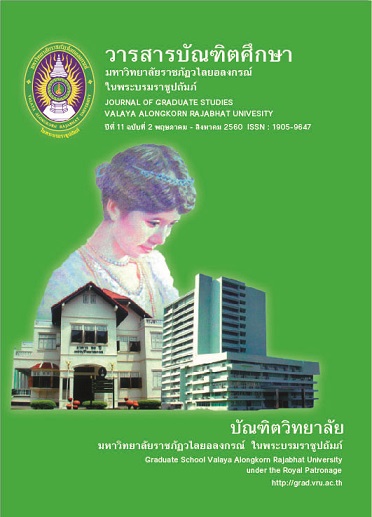ทุนมนุษย์ : ตัวชี้วัดทุนมนุษย์ระดับองค์การ
Main Article Content
Abstract
บทคัดย่อ
บทความเรื่อง “ทุนมนุษย์ : ตัวชี้วัดทุนมนุษย์ระดับองค์การ” มีวัตถุประสงค์เพื่ออธิบายความหมายและความสำคัญของทุนมนุษย์ในฐานะที่เป็นองค์ประกอบหนึ่งของทุนทางปัญญา และเสนอตัวชี้วัดทุนมนุษย์ระดับองค์การ เพื่อใช้เป็นเครื่องมือสำหรับวัดผลตอบแทนจากการลงทุนในทุนมนุษย์ ทุนมนุษย์มีบทบาทสำคัญต่อการพัฒนาองค์การ ทั้งนี้ทุนมนุษย์หมายถึง ความรู้ ทักษะ และความสามารถเฉพาะตัวอื่นๆ ที่สะสมอยู่ในตัวมนุษย์ นอกจากนั้นทุนมนุษย์ยังเป็นกรรมสิทธิ์ส่วนบุคคลที่ไม่สามารถเปลี่ยนถ่ายให้กับบุคคลอื่นได้ ทุนมนุษย์จึงเป็นสินทรัพย์ที่มีคุณค่า ช่วยเสริมสร้างมูลค่าเพิ่มให้แก่องค์การ และนำมาสู่การสร้างความได้เปรียบทางการแข่งขัน อย่างไรก็ตามเนื่องจากทุนมนุษย์เป็นสินทรัพย์ที่จับต้องไม่ได้ การวัดมูลค่าทุนมนุษย์จึงเป็นสิ่งที่ทำได้ยาก ดังนั้นตัวชี้วัดทุนมนุษย์จึงมีบทบาทสำคัญในฐานะที่เป็นแบบแผนการวัดประสิทธิภาพจากการลงทุนในทุนมนุษย์ การเลือกใช้ตัวชี้วัดทุนมนุษย์ให้เหมาะสมกับบริบทขององค์การ จะช่วยให้สามารถวัดผลการดำเนินงานขององค์การได้อย่างมีประสิทธิภาพ
ABSTRACT
The article titled “Human Capital: Corporate Human Capital Scorecard” aims to explain the meaning and importance of human capital as a component of intellectual capital and offer corporate human capital scorecard in order to be a tool for measuring return on investment in human capital. Human capital is very significant in developing organization. The human capital signifies the knowledge, skills and talent that accumulate in the human. Moreover, human capital is viewed as a unique asset that cannot be imitated and substituted by rivals. Consequently, human capital is a valuable asset to increase value added in the organization and also provide sustained competitive advantage. However, human capital is an intangible asset due to the difficulty in the measurement of human capital. As a result, corporate human capital scorecard is a significant scheme to measure the efficiency of investment in human capital. The select on of a suitable corporate human capital scorecard for the organization can be use to measure the efficiently of the organization’s performance.
Article Details
บทความทุกเรื่องได้รับการตรวจความถูกต้องทางวิชาการโดยผู้ทรงคุณวุฒิ ทรรศนะและข้อคิดเห็นในบทความวารสารบัณฑิตศึกษา มหาวิทยาลัยราชภัฏวไลยอลงกรณ์ ในพระบรมราชูปถัมภ์ มิใช่เป็นทรรศนะและความคิดของผู้จัดทำจึงมิใช่ความรับผิดชอบของบัณฑิตวิทยาลัย มหาวิทยาลัยราชภัฏวไลยอลงกรณ์ ในพระบรมราชูปถัมภ์ กองบรรณาธิการไม่สงวนสิทธิ์การคัดลอก แต่ให้อ้างอิงแหล่งที่มา


